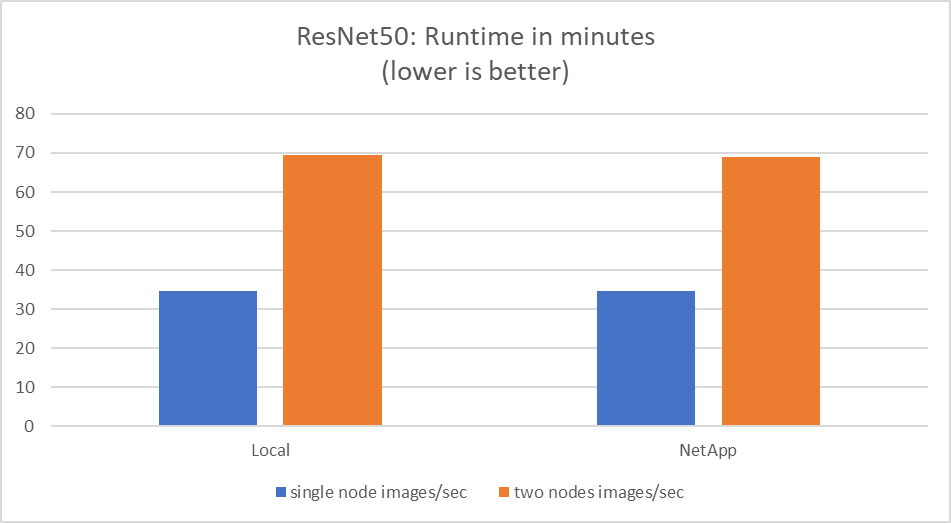Test procedure and detailed results
 Suggest changes
Suggest changes


This section describes the detailed test procedure results.
Image recognition training using ResNet in ONTAP
We ran the ResNet50 benchmark with one and two SR670 V2 servers. This test used the MXNet 22.04-py3 NGC container to run the training.
We used the following test procedure in this validation:
-
We cleared the host cache before running the script to make sure that data was not already cached:
sync ; sudo /sbin/sysctl vm.drop_caches=3
-
We ran the benchmark script with the ImageNet dataset in server storage (local SSD storage) as well as on the NetApp AFF storage system.
-
We validated network and local storage performance using the
ddcommand. -
For the single-node run, we used the following command:
python train_imagenet.py --gpus 0,1,2,3,4,5,6,7 --batch-size 408 --kv-store horovod --lr 10.5 --mom 0.9 --lr-step-epochs pow2 --lars-eta 0.001 --label-smoothing 0.1 --wd 5.0e-05 --warmup-epochs 2 --eval-period 4 --eval-offset 2 --optimizer sgdwfastlars --network resnet-v1b-stats-fl --num-layers 50 --num-epochs 37 --accuracy-threshold 0.759 --seed 27081 --dtype float16 --disp-batches 20 --image-shape 4,224,224 --fuse-bn-relu 1 --fuse-bn-add-relu 1 --bn-group 1 --min-random-area 0.05 --max-random-area 1.0 --conv-algo 1 --force-tensor-core 1 --input-layout NHWC --conv-layout NHWC --batchnorm-layout NHWC --pooling-layout NHWC --batchnorm-mom 0.9 --batchnorm-eps 1e-5 --data-train /data/train.rec --data-train-idx /data/train.idx --data-val /data/val.rec --data-val-idx /data/val.idx --dali-dont-use-mmap 0 --dali-hw-decoder-load 0 --dali-prefetch-queue 5 --dali-nvjpeg-memory-padding 256 --input-batch-multiplier 1 --dali- threads 6 --dali-cache-size 0 --dali-roi-decode 1 --dali-preallocate-width 5980 --dali-preallocate-height 6430 --dali-tmp-buffer-hint 355568328 --dali-decoder-buffer-hint 1315942 --dali-crop-buffer-hint 165581 --dali-normalize-buffer-hint 441549 --profile 0 --e2e-cuda-graphs 0 --use-dali
-
For the distributed runs, we used the parameter server’s parallelization model. We used two parameter servers per node, and we set the number of epochs to be the same as for the single-node run. We did this because distributed training often takes more epochs due to imperfect synchronization between processes. The different number of epochs can skew comparisons between single-node and distributed cases.
Data read speed: Local versus network storage
The read speed was tested by using the dd command on one of the files for the ImageNet dataset. Specifically, we ran the following commands for both local and network data:
sync ; sudo /sbin/sysctl vm.drop_caches=3dd if=/a400-100g/netapp-ra/resnet/data/preprocessed_data/train.rec of=/dev/null bs=512k count=2048Results (average of 5 runs): Local storage: 1.7 GB/s Network storage: 1.5 GB/s.
Both values are similar, demonstrating that the network storage can deliver data at a rate similar to local storage.
Shared use case: Multiple, independent, simultaneous jobs
This test simulated the expected use case for this solution: multi-job, multi-user AI training. Each node ran its own training while using the shared network storage. The results are displayed in the following figure, which shows that the solution case provided excellent performance with all jobs running at essentially the same speed as individual jobs. The total throughput scaled linearly with the number of nodes.


These graphs present the runtime in minutes and the aggregate images per second for compute nodes that used eight GPUs from each server on 100 GbE client networking, combining both the concurrent training model and the single training model. The average runtime for the training model was 35 minutes and 9 seconds. The individual runtimes were 34 minutes and 32 seconds, 36 minutes and 21 seconds, 34 minutes and 37 seconds, 35 minutes and 25 seconds, and 34 minutes and 31 seconds. The average images per second for the training model were 22,573, and the individual images per second were 21,764; 23,438; 22,556; 22,564; and 22,547.
Based on our validation, one independent training model with a NetApp data runtime was 34 minutes and 54 seconds with 22,231 images/sec. One independent training model with a local data (DAS) runtime was 34 minutes and 21 seconds with 22,102 images/sec. During those runs the average GPU utilization was 96%, as observed on nvidia-smi. Note that this average includes the testing phase, during which GPUs were not used, while CPU utilization was 40% as measured by mpstat. This demonstrates that the data delivery rate is sufficient in each case.



 Artificial Intelligence
Artificial Intelligence